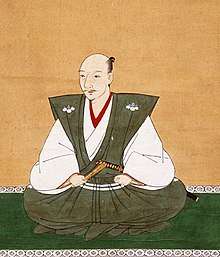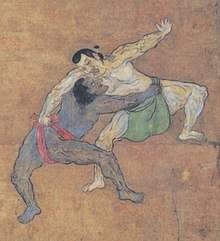Yasuke
Yasuke (variously rendered as 弥助 or 弥介, 彌助 or 彌介 in different sources.[1]) (b. c. 1555–1590) was a Samurai of African origin who served under the Japanese hegemon and warlord Oda Nobunaga in 1581 and 1582.
Contemporary accounts
Early life
According to Histoire Ecclesiastique Des Isles Et Royaumes Du Japon, written by François Solier of the Society of Jesus in 1627, Yasuke was likely from Portuguese Mozambique.[2] Solier's account may, however, have been an assumption as it was written so long after the event and there is no surviving contemporary account that corroborates it.
Still, it is possible that Yasuke was from Mozambique. According to Fujita Midori, first African people came to Japan were Mozambican. They reached Japan in 1546 as shipmates or slaves who served Portguese captain Jorge Alvarez (not to be confused with another explorer of the same name who died in 1521).[3]
A 2013 investigation by the light entertainment television program Discovery of the World's Mysteries (世界ふしぎ発見) suggested that Yasuke was a Makua named Yasufe.[4] This name seems to be derived from the more popular Mozambican name, Issufo.[5] This was not a highly journalistic investigation and the program provided little proof for their conclusions. The Makua didn't have any significant contact with the Portuguese based in Mozambique until 1585.[6] He may have been a member of the Yao people,[7] or from the further inland area of Mozambique.[8] Yao people were just coming into contact with the Portuguese at the time, which might account for his name, Yao, added to the common Japanese male name suffix of suke (Yao-suke).[7]
Another theory states that Yasuke was a Habshi from Ethiopia. Thomas Lockley argued that this theory is most convincing. Like Yasuke, Habshi were called "Cafre" by Portuguese: well‐built and skilled soldiers unlike other east Africans who suffered from famine.[9] According to this theory his original name might be the Ethiopian Yisake or Portuguese Isaque, derived from Isaac.[10] Yasufe was also used as a surname in Ethiopia.[11]
It is also possible that Yasuke was Dinka from South Sudan. He was famous for his height and extremely dark skin color. Dinka people are among the tallest in Africa, and have darker skin than Ethiopians, Eritreans and Somalis. If so, Yasuke would have been enslaved in his childhood. Grown-up men of Dinka drew patterns on their faces, but no account of his face pattern was recorded.[12]
In Japan
Yasuke arrived in Japan in 1579 in the service of the Italian Jesuit Alessandro Valignano, who had been appointed the Visitor (inspector) of the Jesuit missions in the Indies (East Africa, South and East Asia). He accompanied Valignano when the latter came to the capital area in March 1581 and his appearance caused a lot of interest with the local people.
When Yasuke was presented to Nobunaga he suspected his skin to be have been coloured with black ink, Nobunaga had him strip from the waist up and made him scrub his skin.[13] These events are recorded in a 1581 letter of the Jesuit Luís Fróis to Lourenço Mexia and in the 1582 Annual Report of the Jesuit Mission in Japan, also by Fróis. These were published in Cartas que os padres e irmãos da Companhia de Jesus escreverão dos reynos de Japão e China II, normally known simply as Cartas, in 1598.[14] When he realized that his skin was not coloured and in fact black Nobunaga seems to have taken an interest in him.
The Lord Nobunaga Chronicle (信長公記 Shinchō Kōki) corroborates Fróis' account and describes their meeting thus: "On the 23rd of the 2nd month [March 23, 1581], a black page (黒坊主 kuro-bōzu) came from the Christian countries. The man was healthy with a good demeanour and Nobunaga praised Yasuke's strength. Nobunaga's nephew gave him a sum of money at this first meeting.[15]
On May 14, Yasuke departed for Echizen Province with Fróis and other Christians. During this trip, Yasuke met local warlords such as Shibata Katsutoyo, Hashiba Hidekatsu, and Shibata Katsuie.[16]
They returned Kyoto on May 30.[17] At some point, although when is not clear, Yasuke entered Nobunaga's service.

It is likely that Yasuke could speak or was taught considerable Japanese, perhaps due to Valignano's efforts to ensure his missionaries adapted to the local culture better.[18] Nobunaga enjoyed talking with him (there is no indication that Nobunaga spoke Portuguese and it is unlikely that Yasuke would have been able to communicate in classical Chinese, the Asian lingua franca of the time). He was perhaps the only non-Japanese retainer that Nobunaga had in his service, which could explain Nobunaga's interest in him.[18] Yasuke was mentioned in the prototype of Shinchōkōki owned by Sonkeikaku Bunko (尊経閣文庫), the archives of the Maeda clan. According to this, the black man named Yasuke (弥助) was given his own residence and a short, ceremonial katana by Nobunaga. Nobunaga also assigned him the duty of weapon bearer.[19]
After the Battle of Tenmokuzan, Nobunaga led his force including Yasuke, and inspected former territory of Takeda clan. On his way back, he met Tokugawa Ieyasu. Matsudaira Ietada, the retainer of Ieyasu described Yasuke as "6 shaku 2 sun (6 ft. 2 in., or 188 cm.). He was black, and his skin was like charcoal." Matsudaira stated that he was named Yasuke (弥介).[20]
In June 1582, Nobunaga was attacked and forced to commit seppuku in Honnō-ji in Kyoto by the army of Akechi Mitsuhide. Yasuke was there at the time and fought the Akechi forces. Immediately after Nobunaga's death, Yasuke went to join Nobunaga's heir Oda Nobutada who was trying to rally the Oda forces at Nijō Castle. Yasuke fought alongside the Nobutada forces but was eventually captured. When Yasuke was presented to Akechi, the warlord allegedly said that the black man was an animal as well as not Japanese and should thus not be killed but be taken to the nanban-dera or nanban-ji (南蛮寺).[13][21] However, there is some doubt regarding the credibility of this fate,[22] and there is no further written information about him after this.
Artworks depicting Yasuke

There is no confirmed portrait of Yasuke drawn by a contemporary.
Kanō Eitoku was a distinguished painter patronized by Nobunaga. Eitoku had audience with Nobunaga when Yasuke served him. Kanō school was famous for their Nanban byōbu, and there is at least one byōbu depicting a well-dressed black man who could be Yasuke. [23]
An inkstone box made by Rinpa artist in 1590s owned by Museu do Caramulo depicts a black man wearing high-class clothing who appears no longer subordinate to the Portuguese. It is possible that this man is Yasuke in Portuguese attire.[24]
Sumō yūrakuzu byōbu, drawn in 1605c by anonymous artist depicts a black man wrestling with a Japanese man in the presence of noble samurai. This samurai is said to be Oda Nobunaga or Toyotomi Hideyoshi.[25] Nobunaga was famous for his fondness for sumo and held many official matches. This byōbu is owned by Sakai City Museum.[26]
Popular culture
Yasuke was featured in the children's historical fiction novel, Kuro-suke (くろ助) by Yoshio Kurusu (1916–2001) with illustrations by Genjirou Minoda, published in 1968. It features a highly fictionalized and sympathetic accounts. The only thing that is clear is of Yasuke's life in Japan under Nobunaga. The novel received the Japanese Association of Writers for Children Prize in 1969.[27]
He has appeared in numerous movies and dramas about Nobunaga.
Yasuke was the inspiration for Afro, the main character in the popular anime Afro Samurai.
In Yoshihiro Yamada's manga, Hyouge Mono (2005-2017), published in the seinen magazine Weekly Morning, Yasuke witnesses the murder of Nobunaga.
Yasuke is a featured character in the 2017 video game Nioh, from Koei Tecmo. He can be challenged to a duel and is a playable skin in-game. He serves as a bodyguard to the villain of the game, Edward Kelley, and seeks to see his lord Nobunaga revived. He fights alongside an Atlas bear Guardian Spirit.
In March 2017, it was announced that Lionsgate Films and Michael De Luca will produce a film about Yasuke written by Gregory Widen.[28]
See also
References
- ↑ 彌(ya) is the old-style kanji of 弥(ya). 助(suke) and 介(suke) are homophonic kanji. Like this replacement of homophonic was often seen in Edo period.
- ↑ Histoire Ecclesiastique Des Isles Et Royaumes Du Japon, vol.1, p.444. Retrieved 2013-06-22.
- ↑ Fujita, pp.1-2.
- ↑ http://www.tbs.co.jp/f-hakken/bknm/20130608/p_1.html
- ↑ ロックリー 2017, pp. 199-200
- ↑ ロックリー 2017, pp. 180-181
- 1 2 ロックリー 2017, pp. 200-202
- ↑ ロックリー 2017, pp. 181-182
- ↑ ロックリー 2017, pp. 193-194
- ↑ ロックリー 2017, pp. 198-202
- ↑ ロックリー 2017, p. 200
- ↑ ロックリー 2017, pp. 187-188
- 1 2 Fujita, pp.8-9.
- ↑ 1581 letters of the Jesuits Luis Frois and Lorenço Mexia
- ↑ ロックリー 2017, p. 65
- ↑ Fujita, pp.7-8.
- ↑ Fujita, p.8.
- 1 2 Lockley,T., The story of Yasuke: Nobunaga’s black retainer, 桜文論叢、91, 2016.
- ↑ 「織田信長という歴史 『信長記』の彼方へ」、Bensei Shuppan: Tokyo, 2009, pp. 311–312.
- ↑ ロックリー 2017, pp. 77-79
- ↑ Murakami, Naojiro; Yanagitani, Takeo (2002). イエズス会日本年報 上 (新異国叢書) [Society of Jesus - Japan Annual Report, first volume (New Foreign country book series)] (in Japanese). Yushodo-shuppan. ISBN 978-4841910001.
- ↑ 咲村庵 『明智光秀の正体』 73頁 2017年 ブイツーソリューション
- ↑ ロックリー 2017, pp. 147-148
- ↑ ロックリー 2017, pp. 147-148
- ↑ 『第八回特別展 すもう 天下の力士』、葛城市博物館、2007年、10p
- ↑ 『第八回特別展 すもう 天下の力士』、葛城市博物館、2007年、10p
- ↑ "International Institute for Children's Literature, Osaka, One Hundred Japanese Books for Children 1946–1979: Kuro-suke", retrieved on June 30, 2007
- ↑ Fleming Jr., Mike. "Lionsgate Taps 'Highlander' Creator Gregory Widen To Script Film On First Black Samurai". Deadline. Retrieved 23 March 2017.
Specific
- ロックリー・トーマス (February 2017), 信長と弥助――本能寺を生き延びた黒人侍――, translated by 不二淑子, 太田出版, ISBN 978-4-7783-1556-6
- Lockley, T. (2016) "The Story of Yasuke: Nobunaga's Black Retainer", 桜文論叢、91
- Fujita, Midori (2005). アフリカ「発見」日本におけるアフリカ像の変遷 [Discover Africa―History of African image in Japan (World History series)] (in Japanese). Iwanami Shoten. ISBN 978-4000268530.
General
- Matsuda, Kiichi, ed., Jūroku-jūnanaseiki Iezusukai Nihon Hōkokushuu, Hōdōsha, 1987–1998.
- Ōta, Gyūichi, Shinchōkōki, 1622.
External links
- Yasuke: The Real AfroSamurai (documentary)